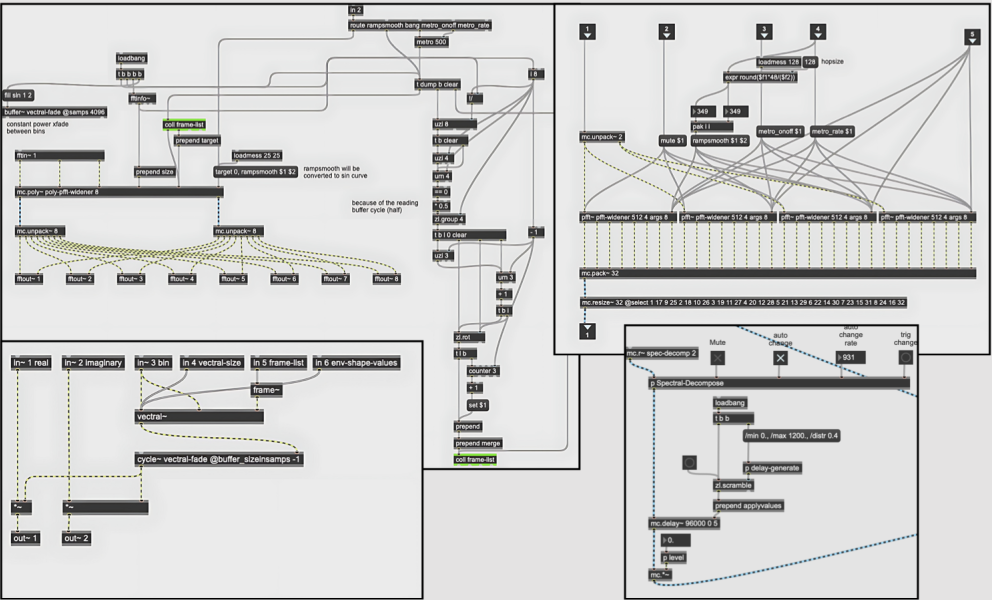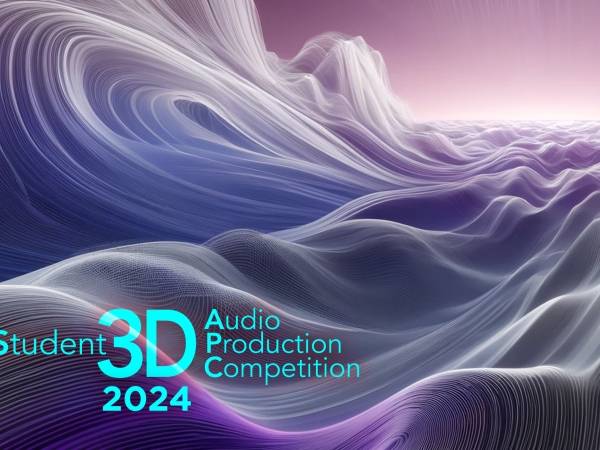12 Minuten
Space in music composition is often seen as a passive backdrop for sound, but this notion is challenged by exploring space as an active, dynamic component that both shapes and is shaped by sound. In this approach, space transcends its traditional role, becoming a fundamental aspect of the compositional process with multiple possibilities for creative expression.
In A Light Stung the Darkness I & II, space is interwoven with sound to create immersive, resonant experiences. These compositions explore the acoustic properties of their respective instruments – an upright piano and viola d'amore – by integrating them within a spatial context that emphasizes the interaction between sound and space. By manipulating this interaction, these pieces invite the listener to engage with music not only as an auditory phenomenon but as an experience that encompasses the entire environment.
These explorations reveal how space can serve as a versatile tool in developing compositional strategies, transforming it from a mere setting into an integral element that informs the structure and expression of the music.
Space: From Concept to Performance
Space can serve as the unifying thread throughout the entire creative process, connecting each stage from conceptualization to performance. These stages are interdependent, each influencing and shaping the others to ensure the final work resonates with spatial coherence.
In the conceptual phase, space functions as both a metaphorical and referential tool, laying a solid foundation for decisions in later stages. This understanding guides the selection of tools, techniques, and strategies that align with the overarching spatial concept, ensuring consistency throughout the process.
As the process moves into production, spatial considerations shape decisions on sound spatialization, design, and orchestration, with each element chosen to enhance the expressiveness of the piece. The timbral space reveals deeper layers of the composition, allowing the music to resonate fully within its intended spatial context.
In performance, space becomes an enacted and performed element, intertwined with human activity and interaction. The spatial relationships established earlier come to life, engaging both real and virtual spaces. This dynamic interplay creates a duality where the physical environment of the performance contrasts with the acousmatic spaces crafted during production, leading the listener through complex navigation between the tangible and the imaginative.
The entire process, from concept to realization, is a cohesive interaction where each stage reinforces and elevates the others, resulting in a multidimensional musical experience.
A Light Stung the Darkness I: Concept and Creation
Composed for the final performance of a one-year residency at IRCAM’s CURSUS program, A Light Stung the Darkness I draw inspiration from a passage in Gaspard de la nuit by Aloysius Bertrand. The title itself, symbolizing the emergence of an idea, serves as both a metaphorical and physical foundation for the composition. This metaphor informs the spatial and sonic world of the piece, guiding the interaction between visual staging and aural landscapes. The piece was premiered at l'Espace de Projection at IRCAM, where its intricate spatial design was fully realized within the venue's large multichannel sound system.
Building the Instrument
The instrument setup for A Light Stung the Darkness I developed through experimentation, aiming to extend the sonic capabilities of the upright piano. The use of fishing lines, tied between the piano strings and a thunder sheet, emerged from these explorations, creating a distinct timbre reminiscent of a “qanun”. By applying bass rosin to the fishing lines and pulling them, the performer can control the density, loudness, and brightness of the sound, effectively granulating the piano’s output and resonating the thunder sheet.
These fishing lines contribute to both the sonic and performative aspects of the piece. They establish a physical connection between the performer, the piano, and the surrounding space, facilitating a choreographed interaction that underscores the spatial dynamics of the performance. The performer’s movements, guided by the tension and release of the lines, create a dialogue between the physical act of playing and the resulting sound.
The setup involves specific modifications to the piano, including the use of patafix, masking tape, and custom inserts to alter its acoustics and eliminate certain harmonics. The fishing lines, precisely measured and treated, are connected to both the piano and the thunder sheet, and placed at a distance, extending the instrument’s sonic reach and integrating it into the performance space as an active component of the composition.
Chordal Space
The chordal space in the piece is defined by the strategic pitch distribution of the notes to which the fishing lines are attached, forming the harmonic backbone of the piece. The harmonic language is intentionally simple and focused, centered around a voicing of an E-flat minor 11 chord. The notes (Eb2, Bb2, Gb3, F4, Db5, and Ab5) are spread across the piano’s range, each chosen to highlight the distinct timbral qualities of the piano in different registers.
This pitch arrangement not only shapes the harmonic structure but also influences the timbral space of the composition. The wide spacing of the chord allows for harmonic shifts as the performer plays notes on the keyboard between the fixed chord tones. This interaction creates a dynamic interplay between the established pitches and the freely played notes, contributing to the evolving harmonic texture of the piece.
Moreover, the widespread chordal space directly impacts the design of the instrument and the spatial setup of the performance. The performer is positioned between three fishing lines on their left and three on their right, all extending to a thunder sheet. This arrangement facilitates a variety of playing techniques, allowing the performer to interact simultaneously with the keyboard, the fishing lines, and the thunder sheet. The spatial distribution of pitches not only defines the sonic character of the piece but also influences the spatial and visual design of the instrument, integrating the physical and auditory elements into a cohesive performance environment.
The decision to fix this chordal space early in the compositional process was crucial, as it determined both the pitch organization and the spatial layout of the performance. This configuration provides a stable foundation for the piece, ensuring that the harmonic, timbral, and spatial elements work together in harmony throughout the performance.
Extending the Instrument to the Virtual Space
In A Light Stung the Darkness I the extension of the instrument into the virtual space is integral to the composition’s conceptual framework. The electronic and spatial design elements are used to shift the audience’s auditory perspective – alternating between placing them inside the instrument, aligning with the performer’s viewpoint, and positioning them outside the performance space. This approach shapes the formal structure and narrative of the piece, creating a context where sound design choices are driven by the need to explore these varied spatial perspectives. The interaction between physical and virtual spaces is not an addition but a fundamental component of how the piece engages with its audience and environment.
In light of this perspective, several crucial decisions were made regarding the electronics. These choices were dictated by the need to support and enhance the spatial concepts at the core of the piece. The following sections illustrate how the electronic design reinforces the overall experience.
Giving Life to the Thunder Sheet
One of the most effective spatial designs in A Light Stung the Darkness I revolves around the thunder sheet. To translate its physical movements into the virtual space, the sound spectrum was divided into three bands using a crossover technique. These frequency bands – low, mid, and high – were then vertically positioned within the ambisonic dome, creating a layered spatial representation from bottom to top.
To further enhance this spatial effect, each band was treated with a stereo tremolo effect, applied at varying rates, which introduced subtle horizontal movement across the sound field. This approach mirrors the physical properties of the thunder sheet, translating them into the 3D virtual space and adding a dynamic, vibrant quality to the sound.
This method represents the core of the spatial design process for the thunder sheet, effectively extending its physical presence into the virtual realm. The full sound design process includes additional details that contribute to the overall experience.
Expanding the Sonic Space: Dynamic Spectral Distribution
Another key technique used to manipulate the virtual space in the piece involves dynamically distributing the piano’s spectrum, particularly in the final section where the fishing lines are prominently featured. This method allows for flexible control over the perceived size and movement of the virtual space, enhancing the immersive quality of the performance.
The process involves dividing the piano’s spectrum into FFT bins, with careful attention given to selecting the window size to match the speaker array. Crossfading between these bins introduces dynamic spatial movement, even when the sound sources remain stationary. Additionally, slight movements are applied to the sources containing these spectral bins, creating a layered sense of motion within the space.
To further enlarge the perceived space, slight delays are introduced to each spectral bin, emulating early reflections. Varying vibrato rates across the bins add dynamism to the sound design, helping to perceptually distinguish each bin and enhance the music’s expressive quality.
This technique effectively mirrors the concept that as the performer moves away from the piano, the virtual space expands. This spatial enlargement ties the performer’s physical movement on stage to the narrative progression and the evolving virtual space, creating a cohesive and immersive experience for the audience.
Integrating VBAP and Ambisonics: A Spatial Dialogue
The integration of both Vector Base Amplitude Panning (VBAP) and Ambisonics in A Light Stung the Darkness I was crucial to achieving the spatial complexity and dynamic range central to the piece. The decision to employ these two distinct spatialization techniques was informed by the specific characteristics of the performance venue, l'Espace de Projection, where the piece was premiered.
The venue's setup, with small speakers for the Ambisonics system and larger, full-spectrum speakers arranged in a 2D format, provided an opportunity to create a spatial spectrum within the sound design. This spectrum allowed for a dynamic interplay between the direct, "in-your-face" presence of the amplified sounds and the expansive, enveloping environment of the Ambisonic field. The result is a dialogue between two different spatial qualities, each contributing to the overall narrative and immersion of the piece.
However, the use of two spatialization techniques also introduced significant challenges, particularly in terms of mixing and sound design. Phasing issues and the complexity of managing numerous mixing parameters required meticulous attention. While theoretical preparation was essential, the process underscored the importance of hands-on experimentation and trusting one's ears in the actual performance space. Allowing for a degree of randomness and physical interaction with the space proved crucial in achieving the intended dialogue between VBAP and Ambisonics, ultimately enhancing the spatial richness and depth of the composition.
A Light Stung the Darkness II: Concept and Creation
Following the performance of the first piece in this series, I had the opportunity to collaborate with Marco Fusi on a new work for viola d'amore and live electronics during a residency at Stanford University. This piece, A Light Stung the Darkness II was specifically composed for performance at CCRMA (Center for Computer Research in Music and Acoustics), a venue equipped with a high-quality ambisonics system, providing an ideal environment to further explore how space can serve as a versatile tool in developing compositional strategies, transforming it from a mere setting into an integral element that shapes the structure and expression of the music.
A Light Stung the Darkness II features a live interaction between the viola d'amore and electronic processes that extend and reveal the instrument's acoustic properties within an expansive timbral space. The piece focuses on the dialogue between the instrument’s sympathetic and actual strings, manipulating their amplified sounds to create a rich, interactive sonic environment. All electronic parameters in the piece are directly influenced by the performer’s actions, ensuring that the electronic manipulation feels as organic and responsive as the acoustic performance itself.
The harmonic language remains simple and deliberately constrained, allowing the timbral nuances of the viola d'amore to take center stage. These nuances transform the straightforward harmonic framework into something uniquely expressive, drawing the listener deeper into the resonant qualities of the instrument. The composition asks a central question: What if the audience found themselves in a room where the walls were made of the strings of a viola d'amore and the air vibrates with the resonance of the instrument? This inquiry drives the spatial and sonic explorations of the piece, creating an immersive and resonant experience.
Amplifying the Instrument's Acoustic Essence
Given the viola d'amore's unique design and timbral qualities, the core idea behind A Light Stung the Darkness II was to amplify these inherent characteristics within the performance space, treating the instrument almost like an architectural element. Every decision, from the formal structure of the piece to the live electronics and spatial treatment, was made to present the viola d'amore's body as the centerpiece, enveloping the audience with its resonant qualities.
The aim was to respect and enhance the natural acoustic properties of the viola d'amore, allowing its distinct sound to fill the space in a way that immerses the listener, making them feel as though they are inside the instrument itself. By doing so, the piece creates a powerful auditory experience that highlights the viola d'amore's rich and complex sound, making it the focal point of the entire performance.
Granular Synthesis as a Spatialization Tool
To achieve the construction and deconstruction of the instrument in real-time and to create the virtual space's "walls" using the viola d'amore's timbral palette, a multichannel granular synthesis device was employed. This device, with its flexible parameters, plays a crucial role in translating the physical vibrations of the instrument into the virtual environment.
Unlike traditional spatialization techniques, this granular synthesis method itself acts as the spatialization tool. The flexibility of the device allows for hundreds of grains to be individually directed to different speakers throughout the venue. Applying crossfades between these grains, creates fluid, dynamic movements that mirror the vibrations occurring within the viola d'amore’s body. This movement within the virtual space mimics the organic characteristics of the instrument, effectively "building" and "dismantling" the instrument's presence in front of the audience.
Moreover, the integration of audio descriptors adds another layer of control, ensuring that the performer’s actions are directly correlated with the spatial movement and timbral evolution of the piece. This approach is akin to setting the physical properties of an acoustic instrument within a virtual environment, establishing rules and behaviors that guide the interaction between sound, space, and performance, much like setting the rules of a game.
A Natural Resonator: Sympathetic Strings
The sympathetic strings of the viola d'amore are essential to the timbral richness of A Light Stung the Darkness II. Capturing and presenting their complex resonances throughout the piece required careful attention to mic placement. A piezo mic was used to capture the resonance of the sympathetic strings, while a contact mic was employed to isolate the actual strings of the instrument.
The piece extensively utilizes open strings and natural harmonic tremolos to bring out the unique qualities of the sympathetic strings. This allows the natural resonance to be a prominent feature, creating intricate and evolving soundscapes. The electronic manipulation applied to these resonances uses a spectral distribution technique similar to the one employed in the first piece of the series, further enhancing the dynamic interplay between the acoustic properties of the instrument and the spatial environment.
The inherent complexity of the sympathetic strings often results in bell-like effects as the instrument's resonance extends into the performance space. The dynamic response of the virtual space to the venue’s acoustics adds a layer of fragility and unpredictability to the performance, deepening the interaction between the performer and the space. Both the audience and the performer experience a sense of being enveloped by the instrument’s body, as the sympathetic strings resonate and fill the space, creating a truly immersive soundscape.
Engin Dağlık
Engin Dağlık is a versatile and innovative composer, artist, and performer, known for his deep passion for sound and music. His work focuses on redefining and transforming the perception of space through sound, encouraging audiences to reimagine environments influenced by his creations. Engin specializes in designing immersive audio experiences, utilizing concrete materials to construct tangible, explicit structures. These creations find their homes in diverse settings, from concerts and galleries to public spaces. Alongside his composition and production work, Engin is an avid performer, showcasing his skills as a drummer and electronic musician in various projects and free improvisation sessions.
Article topics
Article translations are machine translated and proofread.
Artikel von Engin Dağlık
 Engin Dağlık
Engin Dağlık 









